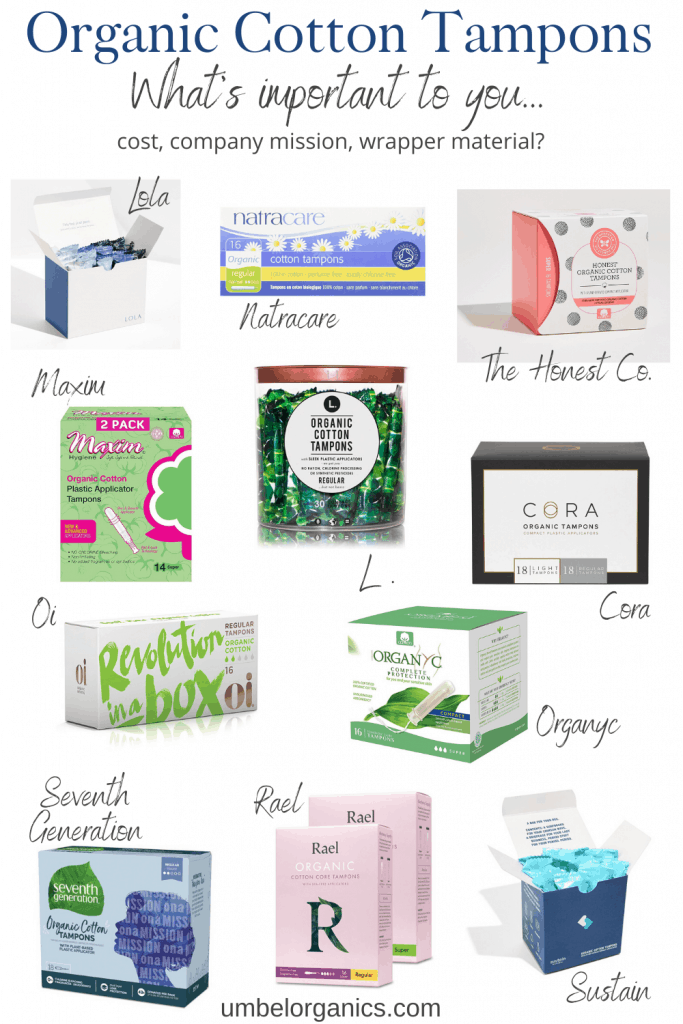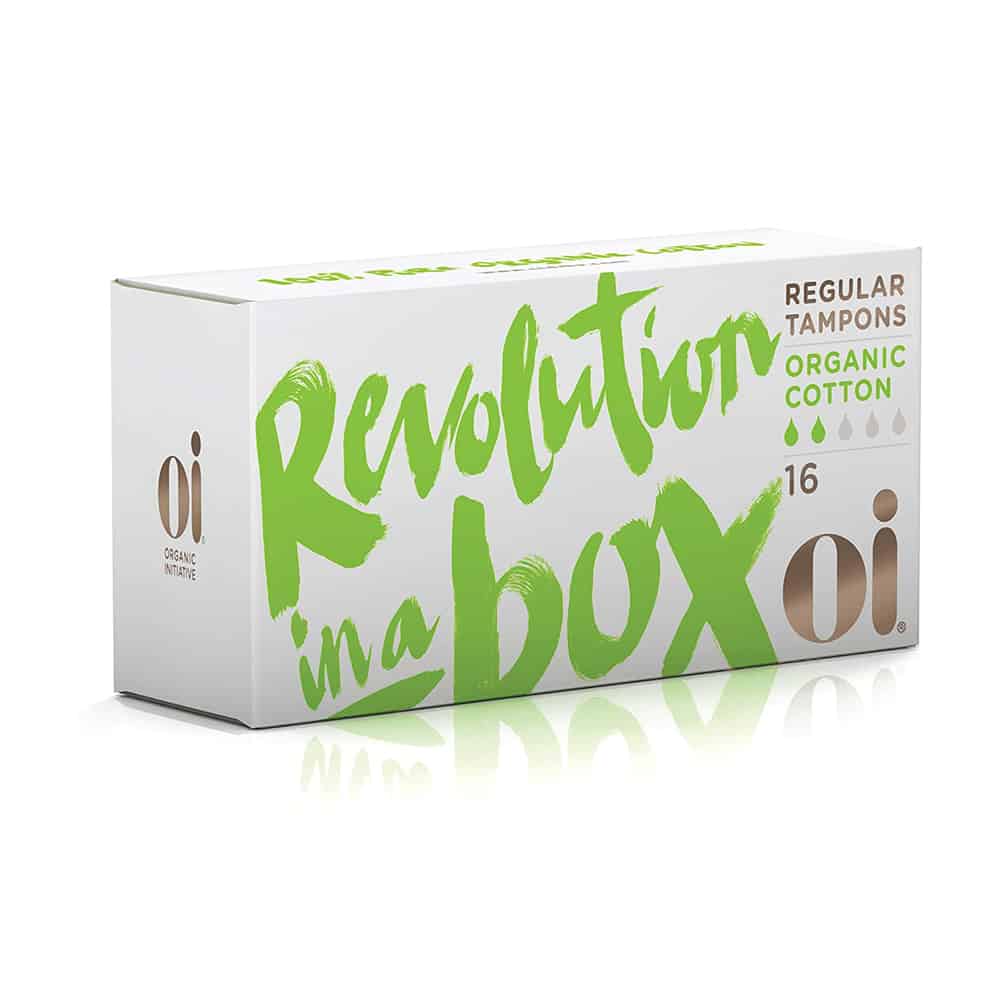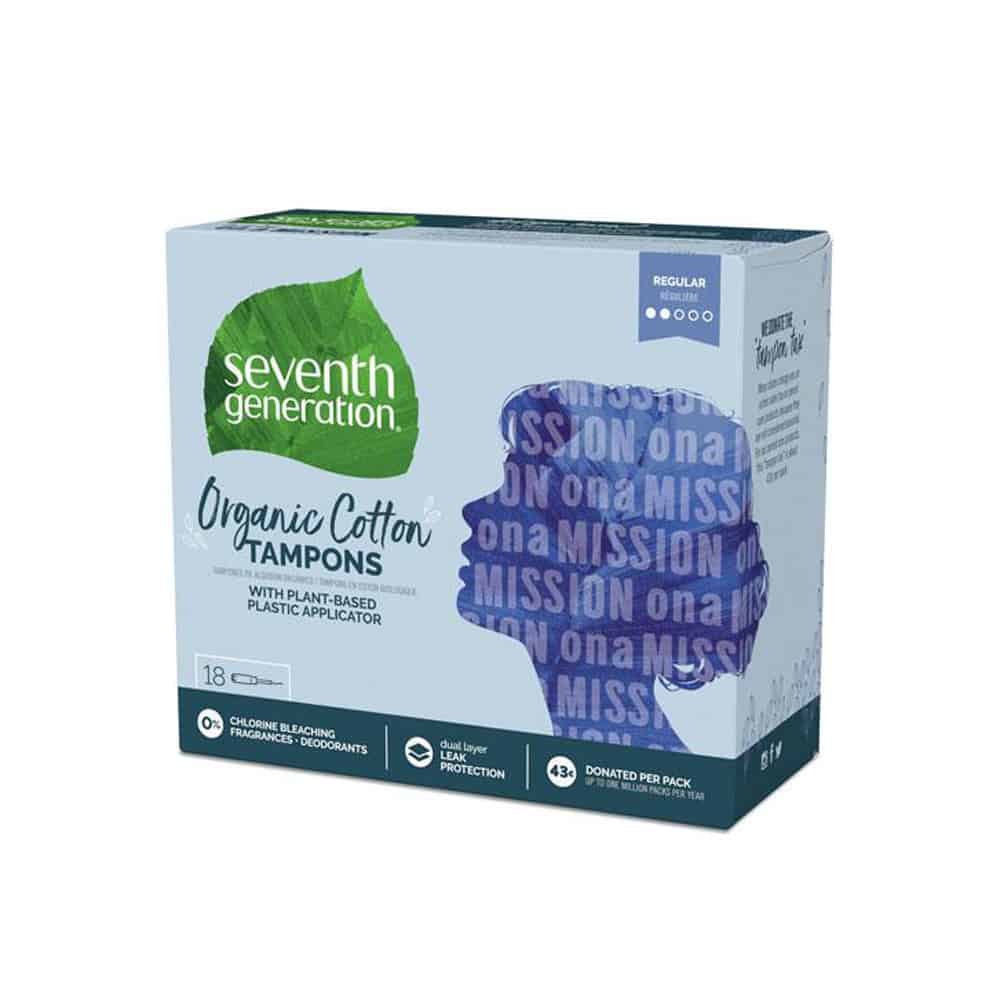Make The Switch To Organic Cotton Tampons
Switch to organic cotton tampons for a healthier, greener option that’s better for you and for the planet. Avoid harmful chemicals in conventional tampons and make the switch to 100% organic cotton tampons.
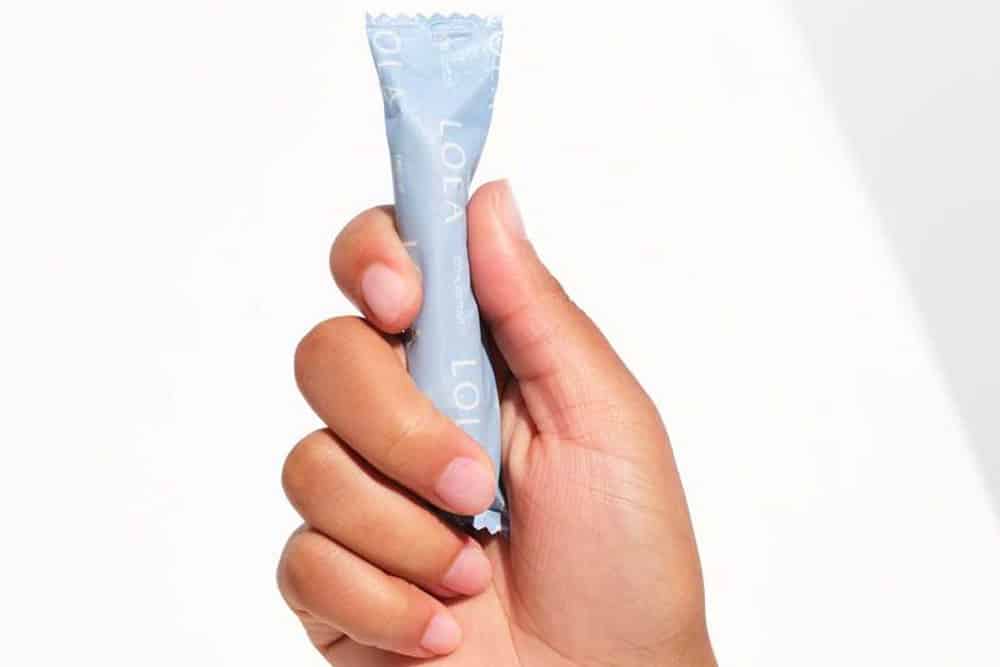
Disclosure: This post contains affiliate links, which means if you make a purchase through these links, we may receive a small commission at no extra cost to you.
There’s a situation in every menstruating women’s life when a tampon comes in handy, be it at the swimming pool or during a workout session at the gym. Although I prefer period pads to tampons, I keep a box of tampons stashed in the bathroom just for those moments.
Conventional tampons contain trace levels of toxins that, over time, can present health risks to the women who use them (1). The skin in the vaginal area is highly permeable, and tampons can be a direct route of chemical exposure for menstruating women (2). Most women wear pads and/or tampons for approximately one week, once a month throughout their entire reproductive lives (excluding pregnancy)—that’s about 7 years!
Since period pads and tampons are regulated as medical devices, manufacturers aren’t required to list all of the ingredients (with the exception of New York State—New York is the first state to require ingredient labels on menstrual products).
Below are some of the studies that have detected harmful chemicals in tampons:
- In 2018, Women’s Voices For The Earth analyzed mainstream, dollar store and organic tampons for volatile and semi-volatile organic compounds (3). Carbon disulfide, a known reproductive toxin used in the manufacturing of rayon, was found in all of the rayon-containing brands of tampons. There was no carbon disulfide detected in the all-cotton tampons tested. Two of the non-organic brands of tampons contained methylene chloride (a carcinogen commonly found in paint strippers). And both brands of non-organic tampons tested contained other volatile organic compounds, including toluene and xylene (reproductive toxins). The 2 organic brands of tampons tested, Natracare and Seventh Generation, did not contain any detectable chemicals of concern.
- Andrea from Naturally Savvy sent a box of OB tampons to the lab for third party pesticide testing (4). Residue from 8 different pesticides were present in the tampons tested. Three of the chemicals detected in the tampons are listed by the EPA as probable human carcinogens, and the other chemicals are toxic to aquatic life and bees. Although the pesticide levels are generally below the residue levels allowable in food, the FDA recommends that tampons be “free of pesticide residue.”
Conventional Pads & Tampons May Contain These Harmful Ingredients
- Pesticide residue from non-organic cotton. Cotton is the world’s most heavily sprayed crop. If your pads or tampons aren’t 100% organic cotton, chances are the cotton has been sprayed with pesticides. Seven of the 15 pesticides commonly used on cotton in the United States are listed as “probable” or “known” human carcinogens by the Environmental Protection Agency (5).
- Dioxins– Dioxins are a byproduct of the chlorine bleaching process, and have been associated with reproductive issues (6). Pulp is now most commonly bleached with an elemental chlorine-free (ECF) process. Although chlorine bleaching was phased out in the 1990’s, a Women’s Voices study found traces of dioxins in tampons tested after this phase out (7).
- Pthalates– Phthalates are used to soften plastics in products such as cosmetics, toys, medical devices and other plastics. A conventional period pad contains up to 4 plastic bags worth of flexible plastic. Pthalate chemicals in the plastic have been linked to a variety of health concerns including endocrine disruption, impacts to reproductive systems (including birth defects), and some forms of cancer (8, 9). A 2019 study on sanitary pads, researchers found two types of pthalate chemicals in all of the 11 brands of sanitary pads tested. The measured pthalate levels in the products tested were significantly higher than what is commonly found in plastic goods (10).
- Synthetic fragrance– Fragrance can irritate sensitive skin and cause allergies and other adverse reactions. The Right To Know report (11) on fragrance ingredients presents data on the chemicals in fragranced beauty, personal care and cleaning products. These chemicals are linked to cancer, birth defects, endocrine disruption and other adverse health effects. Synthetic Fragrance may contain carcinogens, endocrine disruptors, allergens, respiratory irritants and neurotoxic chemicals (12). Synthetic musks like galaxolide and tonalide, are linked to hormone disruption (13). Fragrance is also an often unrecognized source of phthalate exposure, which are hormone disruptors (14).
- Rayon– Rayon is a derivative of wood and non-organic cotton, which is often exposed to pesticides and bleach. Also, carbon disulfide is used in the production of rayon. Exposure to carbon disulfide among rayon manufacturing workers has been associated with menstrual disorders and reproductive effects (15,16).
- Volatile Organic Compounds (VOCs) are used as dissolving agents in the plastic manufacturing process, and one conventional period pad contains up to 4 plastic bags worth of flexible plastic. Researchers in the 2019 study found the following VOCs in the sanitary products: methylene chloride in two brands of sanitary pads; toluene in nine; and xylene in all 11 brands tested (17). In a separate study conducted by Women’s Voices, some brands of tampons contained methylene chloride, a carcinogen commonly found in paint strippers (18).
There’s More To An Organic Tampon Than Meets The Eye
More and more companies are offering unbleached, 100% organic cotton tampons that are free from pesticides, dioxins, phthalates and fragrance in their menstrual products.
However, there are varying materials and characteristics that distinguish each brand from every other brand. With that in mind, I came up with eight categories to help you determine what product most closely matches what’s most important to you. Does cost drive you, company mission, a biodegradable wrapper, applicator type, or maybe all of the above?
All of the brands I’m reviewing use 100% certified organic cotton in their tampons. The eight categories I found information for are as follows: concerning ingredients the product is free from, tampon material, applicator types, wrapper material, tampons sizes offered, cost per 1 tampon*, where the tampons are made and the company mission.
How did I find all of this information? I started with the brand website, where I collected as much information as possible from the product page and the FAQ page. For missing information, I emailed each company with questions.
*Cost was calculated at the time this article was published, and is subject to change.
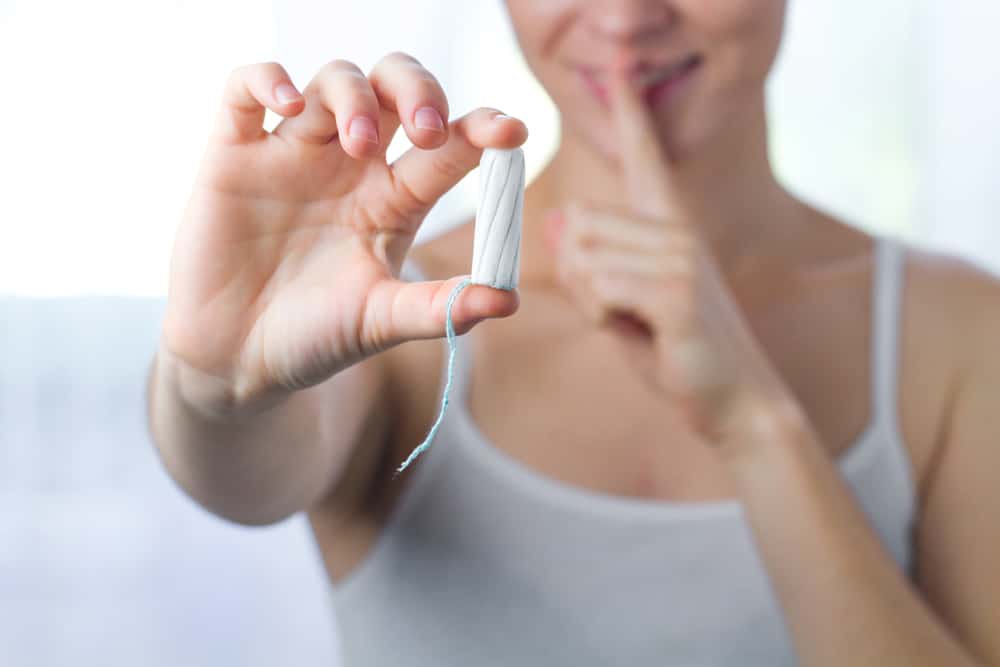
- Free From: Synthetic fibers, chemical additives, fragrance, dyes, chlorine bleach, GMOs, pesticides, toxins, latex and formaldehyde
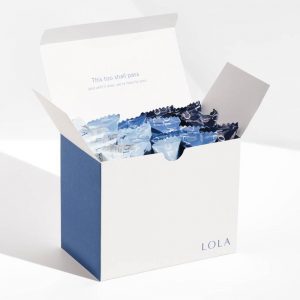
- Material: 100% certified organic cotton
- Applicator: BPA-free plastic applicator, cardboard applicator (flushable), non-applicator
- Wrapper: Recycled plastic for plastic applicator, paper for cardboard applicator
- Tampon sizes: Regular, super, Super plus (no applicator only)
- Cost: $0.56 per plastic applicator tampon, $0.44 per cardboard applicator tampon, $0.50 per non-applicator tampon
- Made in: Made in Europe and packaged in the USA
- Company mission: We partner with leading nonprofits (Period Equity, I Support The Girls, Tax Free. Period.), donate millions of period products, and spark meaningful conversations.
Rael Certified Organic Cotton Tampons
- Free From: Fragrance, chlorine, pesticides, GMOs, dyes, fragrances or other toxic ingredients

- Material: 100% certified organic cotton
- Applicator: Plant-based BPA-free plastic or cardboard
- Wrapper: Recyclable
- Tampon sizes: Regular, super
- Made in: USA and South Korea
- Cost: $0.39 for plastic applicator tampon, $0.39 for cardboard applicator tampon
- Company mission: For every photo shared on Instagram with the hashtag #HappyPeriodsForAll, Rael will donate a period product to a woman in need. Rael supports Los Angeles- based women that are homeless, low-income, and or/living in poverty and provides them with menstrual hygiene kits..
- Free From: Chlorine, plastic, rayon, dyes, pesticides, pthalates, dioxins

- Material: 100% certified organic cotton
- Applicator: Cardboard and non-applicator
- Wrapper: Paper
- Tampon sizes: Regular, super, super plus
- Cost: $0.33 per cardboard applicator, $0.23 per non-applicator tampon
- Made in: Europe
- Company mission: Donate 1% for the Planet. This means we partner with non-profits and charities to help give back to our Earth. Below are just some of the amazing organisations we work with: Marine Conservation Society (MSC), Women Engage for a Common Future (WECF), 5 Gyres, Turning Green, Plastic Pollution Coalition
Oi Certified Organic Cotton Tampons
- Free From: Chlorine bleaching, synthetics such as rayon and polypropylene, toxic chemicals, dyes, fragrances and lubricants
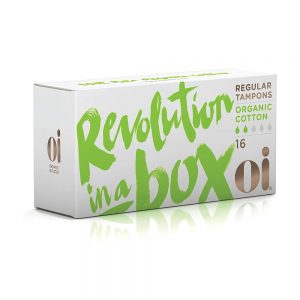
- Material: 100% certified organic cotton
- Applicator: Plant-based plastic applicator, cardboard and non-applicator
- Wrapper: Biodegradable bioplastic wrapper
- Tampon sizes: Regular, super, super plus
- Cost: $0.46 per plastic applicator tampon, $0.45 per cardboard applicator tampon, $0.34 per non-applicator tampon
- Made in: Europe
- Company mission: Oi has a “Change your world this month” campaign to educate women about how to make simple changes, for good.
Seventh Generation Organic Cotton Tampons
- Free From: Chlorine, fragrance, dyes
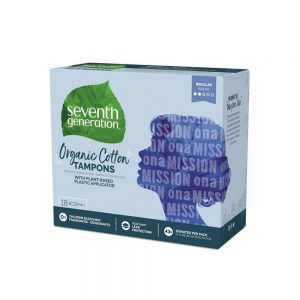
- Material: 100% certified organic cotton
- Applicator: 95% plant-based plastic or non-applicator
- Wrapper: No Information
- Tampon sizes: Light, regular, super, super plus, ultra
- Cost: $0.38 per plastic applicator tampon, $0.34 per non-applicator tampon
- Made in: Germany
- Company mission: Donate 43 cents for every pack of tampons and pads sold in the USA to grassroots organizations working to make access to menstrual products more equitable.
The Honest Company Organic Cotton Tampons
- Free From: Rayon, polyester, fragrances & deodorants, glues & adhesives, polypropylene and pthalates, chlorine/chlorine dioxide processing, antibacterial agents, synthetic zeolites

- Applicator: Plant-derived plastic or non-applicator
- Wrapper: Polyethylene
- Tampon sizes: Regular, super, super plus
- Cost: $0.61 per plastic applicator tampon, $0.35 per non-applicator tampon
- Made in: Slovenia
- Company mission: Honest has partnered with Baby2Baby to help provide diapers, clothing and basic necessities to low-income children across the US.
Sustain 100% Organic Cotton Tampons
- Free From: Chlorine, synthetic fibers, fragrance
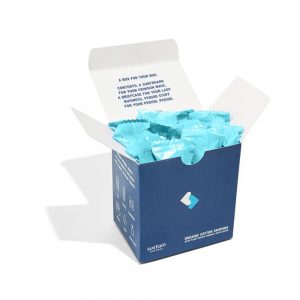
- Material: 100% certified organic cotton
- Applicator: Bioplastic with 90% sugarcane
- Wrapper: Plastic
- Tampon sizes: Regular, super
- Cost: $0.58 per plastic applicator tampon (must have membership to Grove Collaberative)
- Made in: Slovenia
- Company mission: Sustain Naturals gives 10% of profits to women’s healthcare organizations.
Shop Organic Cotton Tampons
Choose Organic Cotton
When it comes to farming, conventionally grown cotton is heavily sprayed. Here are some environmental reasons to buy organic cotton pads and tampons:
- Keep our waterways free from harmful herbicides and pesticides.
- Encourage pollinators to visit crops, and keep the bees, butterflies and birds safe from harmful chemicals.
What Is Toxic Shock Syndrome (TSS) & How To Avoid It
Toxic shock syndrome (TSS) is a rare but life threatening condition. TSS results from the release of toxins due to an overgrowth of staph or strep bacteria. Although TSS can develop without using a tampon (from a skin wound or surgery), this syndrome is associated with the use of tampons.
Bacteria can grow on tampons (even organic cotton tampons), especially if they are not changed often enough. The FDA recommends changing your tampon every 4-8 hours.
Risk of TSS may increase with heavier absorbency tampons. Always use the lightest absorbency possible.
Signs and symptoms of toxic shock syndrome can include: a sudden high fever, low blood pressure, vomiting or diarrhea, a rash resembling a sunburn, particularly on your palms and soles, confusion, muscle aches, redness of your eyes, mouth and throat, seizures and headaches. Seek medical help immediately if you suspect TSS.
Don’t Flush
Even if a tampon applicator or tampon is flushable, please don’t flush it down the toilet. You risk clogging your pipes, and that is not a problem you want to deal with. Properly dispose of tampons and tampon applicators in your garbage can. Any part of the tampon that has blood on it should not be recycled. Some brands have wrappers that can be recycled as long as they are free from blood.


More Natural Living Inspiration
References
- Leithe, R. Why The Toxic Tampon Issue Isn’t Going Away. Ecology and Pioneering, March 2018.
https://environmentalpaper.org/wp-content/uploads/2018/03/RL_7mars_2018-1.pdf - Scranton, A. Potential Health Effects of Toxic Chemicals in Feminine Care Products. Women’s Voices For The Earth. November 2013.
https://www.womensvoices.org/wp-content/uploads/2013/11/Chem-Fatale-Report.pdf - https://www.womensvoices.org/menstrual-care-products/whats-in-your-tampon/
- https://naturallysavvy.com/care/is-there-pesticide-residue-on-your-tampons-our-independent-testing-gets-specific/
- Cubie, Doreen. Cotton and Pesticides: Pick Your Cotton. The National Wildlife Federation. Feb 01, 2006.
https://www.nwf.org/en/Magazines/National-Wildlife/2006/Cotton-and-Pesticides - Dioxins
https://www.niehs.nih.gov/health/topics/agents/dioxins/index.cfm - Scranton, A. Potential Health Effects of Toxic Chemicals in Feminine Care Products. Women’s Voices For The Earth. November 2013.
https://www.womensvoices.org/wp-content/uploads/2013/11/Chem-Fatale-Report.pdf - Patisaul, H.B. and Adawele, H.B. Long-Term Effects of Environmental Endocrine Disruptors on Reproductive Physiology and Behavior. Front Behav Neurosci. 2009; 3: 10.
https://www.ncbi.nlm.nih.gov/pmc/articles/PMC2706654/ - Radke, E.G. et al. Phthalate exposure and male reproductive outcomes: A systematic review of the human epidemiological evidence. Environ Int. 2018 Dec;121(Pt 1):764-793.
https://www.ncbi.nlm.nih.gov/pubmed/30336412 - Chan Jin Park, A. et al. Sanitary pads and diapers contain higher phthalate contents than those in common commercial plastic products. Reprod Toxicol. 2019 Mar; 84: 114–121.
https://www.ncbi.nlm.nih.gov/pmc/articles/PMC6504186/ - Nudelman, J. and Engel, C. Right To Know. Exposing toxic fragrance chemicals in beauty, personal care and cleaning products. Breast Cancer Prevention Partners and Campaign For Safe Cosmetics. Sept. 2018.
https://d124kohvtzl951.cloudfront.net/wp-content/uploads/2018/09/26092837/BCPP_Right-To-Know-Report_Secret-Toxic-Fragrance-Ingredients_9_26_2018.pdf - Nudelman, J. and Engel, C. Right To Know. Exposing toxic fragrance chemicals in beauty, personal care and cleaning products. Breast Cancer Prevention Partners and Campaign For Safe Cosmetics. Sept. 2018.
https://d124kohvtzl951.cloudfront.net/wp-content/uploads/2018/09/26092837/BCPP_Right-To-Know-Report_Secret-Toxic-Fragrance-Ingredients_9_26_2018.pdf - Synthetic Musks. Campaign For Safe Cosmetics. A Project of Breast Cancer Prevention Partners.
http://www.safecosmetics.org/get-the-facts/chemicals-of-concern/synthetic-musks/ - Patisaul, H.B. and Adawele, H.B. Long-Term Effects of Environmental Endocrine Disruptors on Reproductive Physiology and Behavior. Front Behav Neurosci. 2009; 3: 10.
https://www.ncbi.nlm.nih.gov/pmc/articles/PMC2706654/ - Sheffer, Jane. New Tampon Testing Confirms Need For Ingredient Disclosure. Women’s Voices of the Earth. June 2018.
https://www.womensvoices.org/2018/06/05/new-tampon-testing-confirms-need-for-ingredient-disclosure/ - Carbon disulfide
https://www.epa.gov/sites/production/files/2016-09/documents/carbon-disulfide.pdf - Chan Jin Park, A. et al. Sanitary pads and diapers contain higher phthalate contents than those in common commercial plastic products. Reprod Toxicol. 2019 Mar; 84: 114–121.
https://www.ncbi.nlm.nih.gov/pmc/articles/PMC6504186/ - Sheffer, Jane. New Tampon Testing Confirms Need For Ingredient Disclosure. Women’s Voices of the Earth. June 2018.
https://www.womensvoices.org/2018/06/05/new-tampon-testing-confirms-need-for-ingredient-disclosure/
